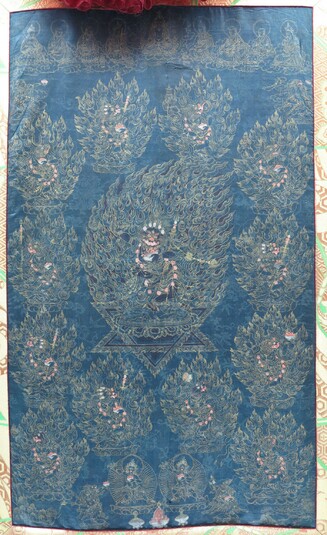
Item: Simhamukha (Buddhist Deity)
| Origin Location | Tibet |
|---|---|
| Date Range | 1700 - 1799 |
| Lineages | Nyingma and Buddhist |
| Material | Ground Mineral Pigment, Black Background on Cotton |
| Collection | Private |
Classification: Deity
Simhamukha, Dakini (Tibetan: seng ge dong chen kha dro ma, English: Lion Faced Dakini) and a retinue of eighteen deities. Simhamukha is a meditational deity and her special function or activity is to remove pollutions, contamination both environmental and emotional, magic and witchcraft. (See the Simhamukha Outline Page).
The Dakini Simhamukha is a female meditational deity with a lion face. She originated in India and is associated with the Chakrasamvara cycle of Tantras and belongs to the Anuttarayoga 'wisdom' classification. In the Nyingma 'Treasure' tradition she is considered to be one of the many forms of Padmasambhava, and more specifically a secret form of Guru Rinpoche Padmasambhava.
"...the wisdom Dakini Simhamukha, with a body blue-black in colour, one face, two hands, three eyes, red, round and glaring, bared fangs and a curled tongue. The right hand holds aloft to the sky a curved-knife marked with a vajra. The left a blood filled skullcup to the heart, carrying a three-pointed khatvanga staff in the bend of the left elbow. Orange hair, eyebrows and beard flowing upwards, with five dry human heads as a crown and fifty wet, blood dripping, as a necklace. With five bone ornaments and a tiger skin as a lower garment, standing on the left leg with the right drawn-up, in the middle of a blazing fire of pristine awareness." [sGrub Thabs Kun bTus, vol.8, folios 288-290. Translated in 1989].
Simhamukha stands atop two interlocked triangles which represent a double tetrahedron. Among the many common geometric shapes and designs in Tantric Buddhist art, the tetrahedron is one of the most unique. The tetrahedron is different and it is important. In Tantric Buddhism, it is both drawn and imagined as a three-dimensional structure. Although the tetrahedron is a four-sided shape, only three sides are closed in the Tantric Buddhist explanation. The pointed end is always directed downward, while the flat, open side faces upward. The symbolic meaning of the shape is emptiness, in which the three closed surfaces at the sides represent the three types of emptiness: wishless, signless, and emptiness itself. Insofar as the tetrahedron represents emptiness, it also stands for the true source of all tantric mandalas of deities.
At the top center is Samantabhadra Buddha with eight teachers of the Nyingma School seated to the right and left. Surrounding the central figure of Simhamukha are twelve retinue deities each with an animal head such as a leopard, tiger, bear, sea monster, raven, dog, boar, etc.
Jeff Watt 12-2015
Buddha Form | Female Form | Wrathful Form
Buddhist Deity: Simhamukha Main Page
Buddhist Deity: Simhamukha Masterworks
Collection of Dhargye Museum
Exhibition: Wrathful Form (DM)
Collection of Dhargye Museum (Painting Gallery 2)

